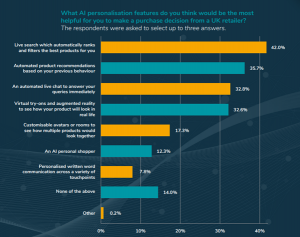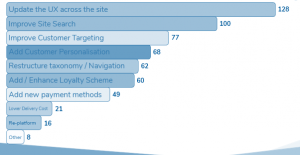By Ellie-Rose Davies, Content Executive at IMRG
According to IMRG’s Online Retail Index data, Q1 (Jan-Mar) revenue in the UK was down -4.6% Year-on-Year (YoY) in 2024. To aid growth, many retailers are focussing on conversion rate optimisation, specifically through foregrounding and refining their ecommerce merchandising strategies.
Results from IMRG’s latest senior retailer survey conducted in Mar/Apr showed that retailers top focus areas this year are on updating the user experience (UX), improving site search, advancing customer targeting, adding personalisation, and focussing on restructure and navigation.
This blog delves more deeply into these areas and provides tactical tips to optimise performance.
Improve your product display
There are various ways retailers can display their products online. The question is – what approaches to product display will attract and convert customers the most?
David Taylor, Country Manager at Aramex explores how ‘In the ever-evolving landscape of online retail, mastering the art of product display is paramount.’ He says, ‘From dynamic carousels to immersive video experiences, retailers seek innovative ways to captivate their audience and outshine competitors.’
‘In 2024, merchandising trends emphasise AI-driven personalisation, seamless integration of augmented reality, and eco-conscious product showcases,’ David continues. ‘Retailers like IKEA, pioneering AR integration exemplify effective merchandising strategies, setting the standard for the industry.’
Andrew Harkness, VP of sales and marketing at Huboo similarly expresses the value of implementing interactive product displays. He shares, “This year, we expect to see more ecommerce brands harnessing the power of 3D and AR to create content and imagery that lets customers get truly up close and personal with their products.’
‘In categories like footwear, jewellery and beauty – where intricate details matter – this not only enriches the online browsing experience for customers, but significantly narrows the gap between expectation and reality, thus reducing the likelihood of items being returned.’
Andrew says, ‘Leveraging user-generated content is another clever strategy to boost sales, and brands like the beauty giant Glossier do this really well. By repurposing UGC that fits with its aesthetic and values, Glossier can turn existing customers into powerful brand ambassadors whilst at the same time ensuring new customers are shown authentic, relatable imagery. It’s a great example of UGC as an ecommerce sales tool.’
Enhance your product recommendations
In an IMRG report supported by Adobe Commerce, it was found that live search which automatically filters the best products and automated product recommendations based on previous behaviour were the most favoured personalisation features for customers. By learning more about customers’ preferences using data and AI, retailers can provide more accurate product recommendations across their website.

Incorporating hyper-relevant product recommendations is particularly useful for targeting those more indecisive shoppers who are likely to abandon purchases. This feature also has the potential to increase average basket values, such as by suggesting complementary products on product descriptive pages (PDPs).
As expressed by Karl Stone, Regional VP at Voyado UK&I, ‘By automatically leveraging smarter product data and data-driven insights on sales trends, stock levels, product newness, and promotions, retailers can adopt their ecommerce sits towards customers and serve the visitor’s real intent.’
Karl recommends ‘a variety of tailored recommendations powered by AI, suited for the start page, category pages, product pages, and checkout steps, to ensure that every customer interaction is personalised, enhancing the journey from start to finish.’ In turn, this can foster ‘brand preference and customer loyalty.’
While reflecting on the value of refining product displays through dynamic carousels, engaging short videos and attractive pop-ups, Burc Tanir, CEO at Prisync also shares how ‘personalised product recommendations, based on customer segmentation and preferences, is pivotal in the current market.’ He says, ‘This can be finely tuned through search algorithms, tailored customer profiles, checkout prompts, and post-purchase follow-ups.’
Alongside AI-driven personalisation, Burc notes that ‘sustainability-focussed product curation and community-driven content creation for social proof and trust-building are amongst the top merchandising trends of 2024.’
Dan Bond, VP of Marketing at RevLifter says ‘If used intelligently, product recommendations can help retailers solve inventory issues by directing visitors to products they want to sell or creating partnership opportunities with suppliers by promoting specific brands or ranges.’
Also, Dan notes how ‘when combined with a strong offer or integrated into one, product recommendations can drive improvements in performance.’
Make site navigation easier
The top way retailers are planning to accelerate their conversion rate for the rest of the year is through updating the user experience across their site. This focus was shared by 128 out of 146 retailers surveyed in IMRG’s recent senior retailer survey. A fantastic way to do this is by prioritising restructure taxonomy/site navigation, which is among the top 5 approaches to growth.

Changes to site navigation and structure doesn’t have to be limited to the areas of the website that are most used during the browsing stage, such as with PDPs. As put by Sean Sherwin-Smith, Post-Purchase Product Director at nShift, ‘Shoppers expect to find what they are looking for quickly, and that goes for delivery options too’ at the checkout.
To create better user experiences Sean says, ‘Online retailers should provide sufficient delivery options to give shoppers what they want, without overwhelming with too much information. Badges and icons make it easy for customers to scan the page and find what they are looking for. For example, a green leaf next to a particular option shows that it’s a more sustainable choice.’
‘They can even have the relevant delivery options displayed on the PDP. A convenient delivery option popping up on this page could act as a way of encouraging customers to put an item in the basket and convert quickly.’
Retailers can also put ‘add to bag’ buttons across various stages of the customer funnel, beyond PDPs, e.g., in email recommendations and on the home page. This may inspire customers to move through the site more quickly, getting them to the checkout stage to boost conversion. This is particularly important as ecommerce add to bag rates has consistently been the worst performing metric of the customer funnel in IMRG’s index.
Want to read more? Here are some other IMRG blogs that cover a range of ecommerce topics:
How Is The Luxury Market Accelerating Growth For 2024? – IMRG
Top Ways To Improve The Post-Purchase Customer Experience – IMRG
8 Red Flags Your Checkout Is Not Optimised For International Customers – IMRG
Ecommerce Quick Wins After A Difficult Start To 2024 – IMRG
Tax Changes To Be Aware Of In 2024 – IMRG
Published 24/04/24



